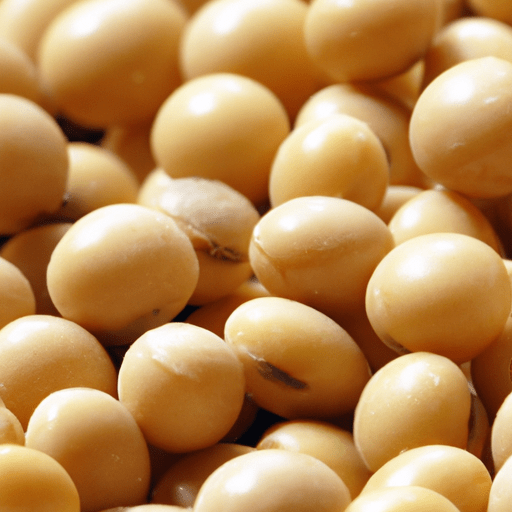The Versatile Soy Bean: A Nutritional Powerhouse
Soy beans, also known as soya beans, are an integral part of many cuisines around the world. These small legumes pack a flavorful punch and are highly versatile in cooking. In this article, we’ll explore the taste profile, common uses, nutritional value, and intriguing history of soy beans.
Taste and Texture
Soy beans have a subtle nutty and buttery flavor with a creamy texture. The taste intensifies when cooked, adding depth and richness to dishes. They have a mild sweetness that complements a wide range of flavors, making them suitable for both savory and sweet preparations.
Common Uses in Cooking
Soy beans are incredibly versatile and can be used in various culinary applications. Here are a few popular uses:
1. Tofu:
Tofu, also known as soybean curd, is made by coagulating soy milk and pressing the resulting curds into blocks. It is a staple in vegan and vegetarian diets as it provides a good source of protein. Tofu comes in different textures, from silky to firm, allowing it to be used in stir-fries, soups, desserts, and even as a meat substitute in burgers and tacos.
2. Tempeh:
A traditional Indonesian product, tempeh is made by fermenting soybeans, creating a firm and chewy block. It has a complex, slightly earthy flavor and is a great source of protein, fiber, and vitamins. Tempeh can be marinated, grilled, sautéed, or crumbled into various dishes like stir-fries, sandwiches, and salads.
3. Soymilk:
Soymilk is a dairy-free alternative to cow’s milk. It is made by soaking, grinding, and boiling soybeans. Soymilk can be used in place of regular milk in beverages, baking, and cooking. Additionally, it can be transformed into homemade tofu or further processed into soy yogurt and ice cream.
4. Edamame:
Edamame refers to young green soybeans contained within the pod. They have a vibrant green color and a slightly sweet taste. Edamame is commonly boiled, steamed, or stir-fried and served as a snack, appetizer, or as a topping for salads, noodles, and rice dishes.
Nutritional Value
Soy beans are not only delicious but also highly nutritious. They are:
- High in Protein: Soy beans are one of the few plant-based foods that provide complete protein, containing all essential amino acids required by our bodies.
- Rich in Fiber: They are an excellent source of dietary fiber, which aids digestion, promotes satiety, and supports heart health.
- Packed with Vitamins and Minerals: Soy beans are a good source of essential minerals like iron, calcium, magnesium, and potassium. They also contain vitamins such as vitamin C, vitamin K, and various B vitamins.
- Healthy Fats: Soy beans are low in saturated fats and rich in unsaturated fats like omega-3 and omega-6 fatty acids, known for their positive impact on heart health.
Interesting History and Facts
Soy beans have a rich history spanning thousands of years. Here are some intriguing facts:
Ancient Crop: Soy beans are one of the oldest known crops, cultivated in China over 5,000 years ago. They spread throughout Asia and eventually gained popularity worldwide.
Plant-Based Protein Powerhouse: Soy beans have played a significant role in providing plant-based protein to populations for centuries, particularly in regions where meat is less accessible.
Versatile Ingredient: The versatility of soy beans allows them to be used to make an incredible assortment of products, including soy sauce, miso, soybean oil, and soy flour, just to name a few.
Sustainable Crop: Soy beans are considered a sustainable crop due to their ability to fix nitrogen in the soil, reducing the need for chemical fertilizers.
Conclusion
Soy beans are a culinary treasure, offering a delightful taste, diverse applications, and numerous health benefits. Their impressive nutritional profile, rich history, and versatility in cooking make them a worthy addition to any kitchen. Next time you come across these humble legumes, embrace their potential and let your creativity flourish in exploring their many exciting culinary possibilities.
Origin:
- Soybeans, also known as soya beans or Glycine max, are native to East Asia, specifically China.
- They have been cultivated and used as a food source for thousands of years in Asian cuisines.
Common Uses:
- Soybeans are widely used to make various soy products, such as soy milk, tofu, tempeh, and soy sauce.
- Soybean oil, extracted from the beans, is a popular cooking oil due to its mild flavor.
- Soybeans are also used to make soy flour, which is often used in baking and as a protein supplement.
Nutritional Benefits:
- Soybeans are a rich source of high-quality protein and are often used as a meat substitute in vegetarian and vegan diets.
- They contain all essential amino acids, making them a “complete” protein source.
- Soybeans are an excellent source of dietary fiber, vitamins (such as vitamin K, folate, and vitamin C), and minerals (including iron, magnesium, and potassium).
- They are relatively low in saturated fat and cholesterol-free.
Unique Properties and Historical Significance:
- Soybeans are one of the few plant-based protein sources that contain all nine essential amino acids required by the human body.
- The cultivation and consumption of soybeans spread from China to other parts of Asia and eventually to Europe and the Americas.
- Soybeans played a significant role in the Green Revolution, a period of agricultural advancements in the mid-20th century that greatly increased crop productivity.
- In some traditional Asian cultures, soybeans are considered one of the five sacred crops alongside rice, wheat, barley, and millet.




Use the share button below if you liked it.
It makes me smile, when I see it.